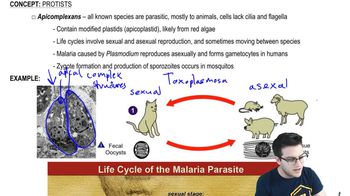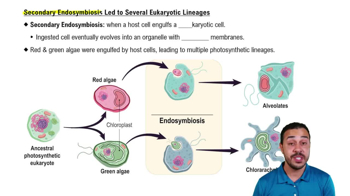Table of contents
- 1. Introduction to Biology2h 42m
- 2. Chemistry3h 40m
- 3. Water1h 26m
- 4. Biomolecules2h 23m
- 5. Cell Components2h 26m
- 6. The Membrane2h 31m
- 7. Energy and Metabolism2h 0m
- 8. Respiration2h 40m
- 9. Photosynthesis2h 49m
- 10. Cell Signaling59m
- 11. Cell Division2h 47m
- 12. Meiosis2h 0m
- 13. Mendelian Genetics4h 44m
- Introduction to Mendel's Experiments7m
- Genotype vs. Phenotype17m
- Punnett Squares13m
- Mendel's Experiments26m
- Mendel's Laws18m
- Monohybrid Crosses19m
- Test Crosses14m
- Dihybrid Crosses20m
- Punnett Square Probability26m
- Incomplete Dominance vs. Codominance20m
- Epistasis7m
- Non-Mendelian Genetics12m
- Pedigrees6m
- Autosomal Inheritance21m
- Sex-Linked Inheritance43m
- X-Inactivation9m
- 14. DNA Synthesis2h 27m
- 15. Gene Expression3h 20m
- 16. Regulation of Expression3h 31m
- Introduction to Regulation of Gene Expression13m
- Prokaryotic Gene Regulation via Operons27m
- The Lac Operon21m
- Glucose's Impact on Lac Operon25m
- The Trp Operon20m
- Review of the Lac Operon & Trp Operon11m
- Introduction to Eukaryotic Gene Regulation9m
- Eukaryotic Chromatin Modifications16m
- Eukaryotic Transcriptional Control22m
- Eukaryotic Post-Transcriptional Regulation28m
- Eukaryotic Post-Translational Regulation13m
- 17. Viruses37m
- 18. Biotechnology2h 58m
- 19. Genomics17m
- 20. Development1h 5m
- 21. Evolution3h 1m
- 22. Evolution of Populations3h 52m
- 23. Speciation1h 37m
- 24. History of Life on Earth2h 6m
- 25. Phylogeny2h 31m
- 26. Prokaryotes4h 59m
- 27. Protists1h 12m
- 28. Plants1h 22m
- 29. Fungi36m
- 30. Overview of Animals34m
- 31. Invertebrates1h 2m
- 32. Vertebrates50m
- 33. Plant Anatomy1h 3m
- 34. Vascular Plant Transport1h 2m
- 35. Soil37m
- 36. Plant Reproduction47m
- 37. Plant Sensation and Response1h 9m
- 38. Animal Form and Function1h 19m
- 39. Digestive System1h 10m
- 40. Circulatory System1h 57m
- 41. Immune System1h 12m
- 42. Osmoregulation and Excretion50m
- 43. Endocrine System1h 4m
- 44. Animal Reproduction1h 2m
- 45. Nervous System1h 55m
- 46. Sensory Systems46m
- 47. Muscle Systems23m
- 48. Ecology3h 11m
- Introduction to Ecology20m
- Biogeography14m
- Earth's Climate Patterns50m
- Introduction to Terrestrial Biomes10m
- Terrestrial Biomes: Near Equator13m
- Terrestrial Biomes: Temperate Regions10m
- Terrestrial Biomes: Northern Regions15m
- Introduction to Aquatic Biomes27m
- Freshwater Aquatic Biomes14m
- Marine Aquatic Biomes13m
- 49. Animal Behavior28m
- 50. Population Ecology3h 41m
- Introduction to Population Ecology28m
- Population Sampling Methods23m
- Life History12m
- Population Demography17m
- Factors Limiting Population Growth14m
- Introduction to Population Growth Models22m
- Linear Population Growth6m
- Exponential Population Growth29m
- Logistic Population Growth32m
- r/K Selection10m
- The Human Population22m
- 51. Community Ecology2h 46m
- Introduction to Community Ecology2m
- Introduction to Community Interactions9m
- Community Interactions: Competition (-/-)38m
- Community Interactions: Exploitation (+/-)23m
- Community Interactions: Mutualism (+/+) & Commensalism (+/0)9m
- Community Structure35m
- Community Dynamics26m
- Geographic Impact on Communities21m
- 52. Ecosystems2h 36m
- 53. Conservation Biology24m
5. Cell Components
Endosymbiotic Theory
Problem 1`
Textbook Question
Plastids that are surrounded by more than two membranes are evidence of
a. Evolution from mitochondria.
b. Fusion of plastids.
c. Origin of the plastids from archaea.
d. Secondary endosymbiosis.
 Verified step by step guidance
Verified step by step guidance1
Understand the concept of plastids: Plastids are organelles found in the cells of plants and algae, primarily involved in photosynthesis and storage of products like starch. They are typically surrounded by two membranes.
Learn about endosymbiosis: Endosymbiosis is a theory that explains how certain organelles, like mitochondria and plastids, originated from free-living bacteria that were engulfed by ancestral eukaryotic cells.
Explore secondary endosymbiosis: Secondary endosymbiosis occurs when a eukaryotic cell engulfs another eukaryotic cell that already contains plastids, leading to plastids with more than two membranes.
Analyze the options: Consider each option in the context of plastids with more than two membranes. Evolution from mitochondria (a) is unlikely as mitochondria are distinct organelles. Fusion of plastids (b) does not typically result in additional membranes. Origin from archaea (c) is not supported by current evidence.
Conclude with secondary endosymbiosis: The presence of more than two membranes around plastids is indicative of secondary endosymbiosis, where additional membranes are acquired during the engulfment process.
 Verified video answer for a similar problem:
Verified video answer for a similar problem:This video solution was recommended by our tutors as helpful for the problem above
Video duration:
1mPlay a video:
Was this helpful?
Key Concepts
Here are the essential concepts you must grasp in order to answer the question correctly.
Plastids
Plastids are organelles found in the cells of plants and algae, primarily involved in photosynthesis and storage. They include chloroplasts, chromoplasts, and leucoplasts, each serving different functions. Plastids are typically surrounded by two membranes, but variations exist due to evolutionary processes.
Recommended video:
Guided course

Apicomplexans
Endosymbiosis
Endosymbiosis is a theory explaining the origin of certain organelles, like mitochondria and plastids, through a symbiotic relationship where one organism lives inside another. Primary endosymbiosis involves the engulfment of a prokaryote, while secondary endosymbiosis involves a eukaryotic cell engulfing another eukaryotic cell, leading to organelles with more than two membranes.
Recommended video:
Guided course

Endosymbiotic Theory
Secondary Endosymbiosis
Secondary endosymbiosis occurs when a eukaryotic cell engulfs another eukaryotic cell that already contains plastids, resulting in plastids surrounded by more than two membranes. This process is a key evolutionary step in the diversification of algae and explains the complex membrane structures found in some plastids.
Recommended video:
Guided course

Secondary Endosymbiosis Led to Several Eukaryotic Lineages
Related Videos
Related Practice









